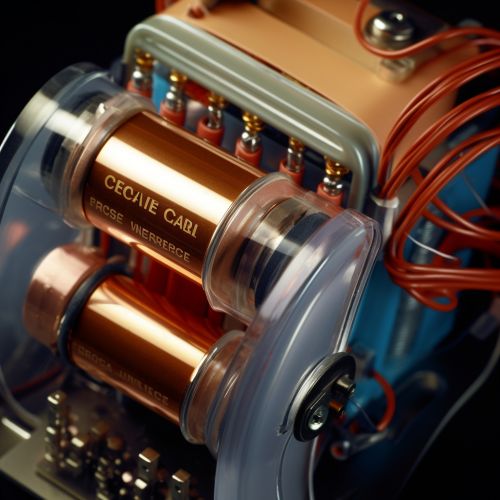Film capacitor
Introduction
A film capacitor is a type of capacitor that uses a thin plastic film as the dielectric. This film is made extremely thin using a sophisticated film drawing process. Once the film is manufactured, it may be metallized or left untreated, depending on the needed properties of the capacitor.
Construction
Film capacitors are made by creating a thin film of a dielectric material, then applying a metallic layer to serve as electrodes. The film is typically made of a high-permittance material such as polypropylene or polyester, and the electrodes are usually made of aluminum or zinc. The film is wound into a cylindrical shape, and then leads are attached to the metal layer. The entire assembly is then encapsulated in a plastic case for protection.


Types of Film Capacitors
There are several types of film capacitors, including polyester film, polypropylene film, metalized film, and polyethylene naphthalate film capacitors.
Polyester Film Capacitors
Polyester film capacitors are known for their high dielectric constant and relatively low cost. They are often used in DC-link circuits, power factor correction circuits, and motor run applications.
Polypropylene Film Capacitors
Polypropylene film capacitors have a lower dielectric constant than polyester film capacitors, but they have superior loss characteristics, making them suitable for AC signal and power use. They are often used in resonant circuits and power factor correction applications.
Metallized Film Capacitors
Metallized film capacitors have a thin layer of metal applied to the dielectric film. This results in a self-healing mechanism that can clear faults in the capacitor. They are often used in power electronics, including power conditioning and DC-link applications.
Polyethylene Naphthalate Film Capacitors
Polyethylene naphthalate film capacitors have a high dielectric constant and excellent thermal stability. They are often used in high-frequency and high-stability applications.
Characteristics
Film capacitors have several characteristics that make them suitable for a variety of applications. These include low equivalent series resistance (ESR), low dissipation factor, high insulation resistance, and long life span.
Low Equivalent Series Resistance
The equivalent series resistance (ESR) of a capacitor is a measure of the internal resistance of the capacitor. Film capacitors have a low ESR, which means that they can handle high ripple currents without overheating.
Low Dissipation Factor
The dissipation factor of a capacitor is a measure of the loss of energy in the capacitor. Film capacitors have a low dissipation factor, which means that they are efficient and do not waste much energy.
High Insulation Resistance
The insulation resistance of a capacitor is a measure of the resistance between the two terminals of the capacitor. Film capacitors have a high insulation resistance, which means that they do not leak much current.
Long Life Span
Film capacitors have a long life span, often exceeding 10,000 hours. This makes them suitable for applications where reliability and longevity are important.
Applications
Film capacitors are used in a wide range of applications, including power electronics, motor drives, telecommunications equipment, and energy storage systems.
Power Electronics
In power electronics, film capacitors are used in DC-link circuits, power factor correction circuits, and snubber circuits. They are chosen for their low ESR, low dissipation factor, and long life span.
Motor Drives
In motor drives, film capacitors are used in the input and output filters. They are chosen for their ability to handle high ripple currents and their long life span.
Telecommunications Equipment
In telecommunications equipment, film capacitors are used in power supplies and signal processing circuits. They are chosen for their high insulation resistance and low dissipation factor.
Energy Storage Systems
In energy storage systems, film capacitors are used in power conditioning circuits and energy storage circuits. They are chosen for their low ESR, high insulation resistance, and long life span.
